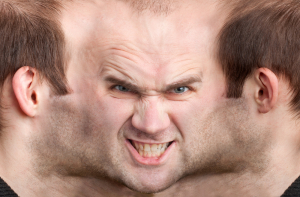Schizoaffective disorder is a psychotic disorder which lasts at least 1 month or longer and where a mood disorder is present for a substantial portion of the total duration of the schizophrenia, which is present at the same time.
For instance, a patient may present with schizophrenic symptoms of hallucinations, delusions and others, which are usually present first.
Then there would be a period of time when depressive symptoms are superimposed for perhaps 3 months and eventually the schizophrenic symptoms would abate perhaps after 5 months of total duration. This would be an example of a bout of schizoaffective disorder, which resolved. However, for some patients schizoaffective disorder lasts for several years and even several decades. Typically it starts in early adult life. Instead of a depressive mood disorder a bipolar mood disorder may be present.
The long term prognosis is better for bipolar type schizoaffective disorder than it is for depressive type schizoaffective disorder.
First degree relatives of patients with schizoaffective disorder are at an increased risk to develop either schizophrenia or a mood disorder.
Treatment consists of a combination of psychotropic medication, psychotherapeutic counseling and psychosocial community support. For the manic(bipolar) type antipsychotic medication is combined with lithium. With the depressive type antipsychotic medication is combined with antidepressants, or one of the atypical antipsychotic medications may be beneficial.
References:
1. Dr. David Burns: “Feeling good –The new mood therapy”, Avon Books, New York,1992.
2. Diagnostic and Statistical Manual of Mental Disorders, Fourth Edition, (DSM-IV),American Psychiatric Association, Washington,DC,1994.
3. Dr. Shaila Misri at the 46th St. Paul’s Hosp. Cont. Educ. Conference, November 2000, Vancouver/B.C./ Canada.
4. JM Loftis et al. J Neurochem 2000 Nov 75(5): 2040-2050.
5. B. Zilbergeld et al. “Hypnosis – Questions& Answers”, W.W. Norton & Co, New York,1986: 307-312.
6. MH Erickson & EL Rossi:”Hypnotherapy, an exploratory casebook”, Irvington Publishers Inc., New York, 1979: chapter 8, 314-363.
7. G Steketee et al. Compr Psychiatry 2001 Jan 42(1): 76-86.
8. DS Mennin et al. J Anxiety Disord 2000 July-Aug 14(4): 325- 343.
9. J Hartland: “Medical &Dental Hypnosis and its Clinical Applications”, 2nd edition, Bailliere Tindall,London,1982, page: 326-336.







